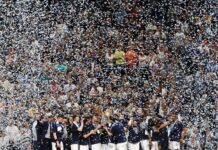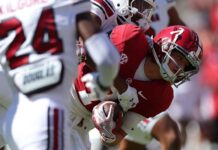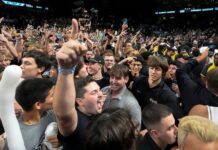[ad_1]
The Big 12 conference became the first named party in the House v. NCAA lawsuit to vote to settle the lawsuit and related antitrust lawsuit, sources told ESPN, ushering in a new era in college athletics.
Big 12 presidents and chancellors voted virtually Tuesday afternoon to approve unanimously, with outgoing members Texas and Oklahoma abstaining. All 12 continuing members of this year’s conference voted to pass. The other four power conferences and the NCAA Board of Governors are expected to vote in the coming days. The settlement is expected to pass overwhelmingly, charting a new course for college sports.
Sources have consistently indicated to ESPN that there is little resistance at the conference level and that the NCAA is expected to pass the settlement measure. (The Pac-12 will vote as a full 12-team league, as currently constructed, as it was at the time the House v. NCAA lawsuit was filed.)
Sources told ESPN that Big 12 presidents and chancellors were briefed in recent days on a 13-page term sheet that contained settlement language.
Key parts of the settlement will include the NCAA paying more than $2.7 billion in back damages over a decade, including about $1.6 billion withheld from schools.
There is also approximately $20 million in projected revenue sharing that is expected to begin in the fall of 2025. This revenue sharing would give athletic departments direct power to pay players, a huge paradigm shift for college athletics.
The point of the school’s settlement is to avoid larger damages down the road, which legal experts see as a possibility given the NCAA’s poor record in court cases.
Only a majority vote of the leagues is needed to approve the settlement, and according to ESPN sources the conference is not believed to have enough momentum to prevent opponents from voting.
But there’s still a tinge of uncertainty across the landscape, as school presidents meet both virtually and in person this week.
On campus, school officials are meeting and scrambling to figure out how to adjust to the new paradigm. Major league schools have to find about $20 million in athletic budgets and figure out how to divvy it up. The minor leagues are adjusting how to cover costs, as the NCAA withholds various amounts from schools at all levels of Division I to cover costs.
There is no clarity on Title IX’s role in revenue sharing, how roster caps will work, and how name images and likenesses will be applied. (NIL is expected to exist without revenue sharing.)
Sources have indicated that it will take at least six months, possibly longer, until these details are worked out. Several more steps are expected before Senior District Judge Claudia Wilkin approves the settlement. All Division I athletes have the opportunity to object to the terms or opt out of the class.
Wilkin is also required to hold a preliminary hearing to review the terms of the settlement. Later, he has to consider any increase presented against it before formally ruling on the settlement. All these projects will take months to unfold.
Congress is also expected to continue to be asked to work toward narrower exemptions from future lawsuits. The industry’s belief is that Congress may be more willing to help college sports, as opposed to save them, now that a framework is moving forward that includes revenue sharing for players.
Lawyers in the House case and two other related cases — Hubbard and Carter — include veteran antitrust lawyers Jeffrey Kessler and Steve Berman. Kessler has been at the forefront of the sports labor movement for decades, including the O’Bannon v. NCAA lawsuit in 2014. Berman has been involved in several anti-trust cases against the NCAA, including the Alston case, which was upheld by the Supreme Court. In 2021.
ESPN staff writer Dan Murphy contributed to this report.
[ad_2]











